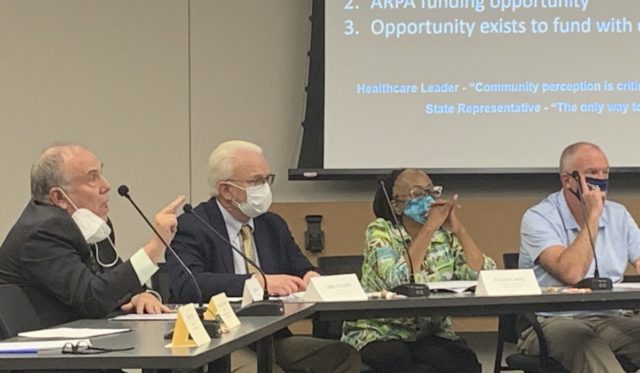

An architectural firm hired by the Oklahoma County Criminal Justice Advisory Council to study options for the county’s troubled jail recommended on Thursday construction of an entirely new facility, which would cost as much as $300 million and would house approximately 1,800 inmates, with the possibility to be scaled up to house 2,800.
The report was presented by staff from both FSB, an Oklahoma City-based architectural firm, and HOK, an engineering firm with projects across the globe, according to its website.
The firms have spent the past several months studying options including construction of a new Oklahoma County jail, construction of an annex and renovation of the current facility.
Construction for the recommended new facility would begin as early as 2024 and would take about two years to complete. The renovation and annex options at the current facility would cost an estimated $276 million and would follow a similar timeline, according to the firms’ study.
CJAC member Dan Straughan, who sits on the facilities subcommittee, said after hearing the FSB report he believes a new jail is the best approach.
“The data seems very clear to us,” Straughan said. “The front end costs of a completely new jail are higher, marginally. A new jail is much more humane. The building we have is just not fixable. It just isn’t. I would move, and the subcommittee would move, to direct the consultants to focus their remaining efforts strictly on a new jail and stop trying to figure out a way to retrofit the old jail or retrofit an annex. Neither one of those options is going to get us to a safe, humane detention center. The debate over right-sizing, that’s to come.”
‘We absolutely can pay for this’
Determining how to pay for a new jail is one of the first obstacles for the project. Public finance attorney Leslie Batchelor said a new jail could be paid for through a combination of bonds and $154 million in American Rescue Plan funds.
“We absolutely can pay for this. the ARPA funds give us a once-in-a-lifetime opportunity to really do this and do it right,” Batchelor told the council.
An additional $95 million could be raised over 25 years through general obligation bonds. A further $48 million could be raised with revenue-anticipation bonds and another $95 million through lease-purchase revenue bonds.
The general obligation bonds would require the approval of county residents.
“Using the bonds does require us to go to voters to continue that tax, but, just the way the city of Oklahoma City has done with its GO bond program, just asking the voters to keep their taxes the way they are today, not a tax increase, just continue what we’re doing today — if we go with that pitch we could raise at least $95 million over 25 years,” Batchelor said.
Batchelor said she believes voters would back the project.
“Personally I believe that with the commitment that the county and the community is showing to criminal justice reform, we can take that to the voters, pitch it as the humane facility that we need to solve this problem in the community, we can get that done,” she said.
Batchelor said the ARPA funds would need to be committed by the end of 2024 in order to be used on the project.
‘We got people down there dying’
Even among those who support the construction, determining how big a new jail should be and how to manage the current facility during the transition is an early bone of contention.
The current jail’s average population in late September was about 1,650 inmates. That number is down from 2015, when the jail’s population hit a peak of 2,800.
Some have advocated for construction of a smaller jail, pointing to public services coming online through MAPS 4 in the coming years which could help divert people away from the criminal justice system in the first place. The current jail was designed to hold 1,200 inmates, but over the years beds have been added to cells to increase that capacity.
CJAC member Judge Philippa James said she doesn’t think such a large facility is needed.
“If we take advantage of all the things voted on in MAPS, like the Diversion Hub and stuff with other community partners, it seems to me we’re not going to need a 1,200-bed facility,” James said. “If we start figuring out a way to not put people in jail, we don’t need a huge complex.”
CJAC member Robert Ravitz said the jail is already overcrowded and in violation of statutes, which he said could result in a takeover of the jail by the Department of Justice. Ravitz said there are risks to building too small of a facility.
“In a perfect world, Judge James, I totally understand 1,200 beds or whatever,” Ravitz said. “But let’s talk about what happens when you build a facility that isn’t big enough. As soon as we opened the facility, we started double-celling. Then we started triple-celling. When you start triple-celling you have problems with trash, your cooking facility and laundry, and that leads to roach and bed bug infestation. But don’t get me wrong — I don’t want to build a 2,500-bed facility. But if we build it too small and we don’t have the funds available to expand that facility, what happens is ‘Where do we put them?’ It’s imperative the facility be sufficient to house an expanding community.”
CJAC member Rev. Theodis Manning said he was also concerned about what state the current jail would be left in as resources are directed to construction of a new jail.
“I’m all for building a new jail,” he said. “Being one who has been on both sides of the fence — it’s been over 20 years ago, thank God — but I would hope that we could put some immediate and intense attention on the crisis that we have going on in the jail right now. Again, I’m all for building a jail, but we’re talking two or three years. But we got people down there dying. We got people getting eaten up by bed bugs. It’s bad, and some of it is even life-threatening. We have to stop the bleeding that’s going on right now.”
CJAC chairman Clay Bennett also shared those concerns.
“We said at our first meeting we must and we will be successful,” Bennett said in response to Manning. “We will absolutely pursue that. I care about that a great deal.”
Bennett said CJAC intends to make a formal recommendation to the Oklahoma County Commissioners and the Oklahoma County Criminal Justice Authority on Nov. 18.
New dashboard launched
A dashboard that allows members of the community to track the jail population, how long inmates have been held and the average bond amounts, among other metrics, has been launched by CJAC. The dashboard can be found here.




















